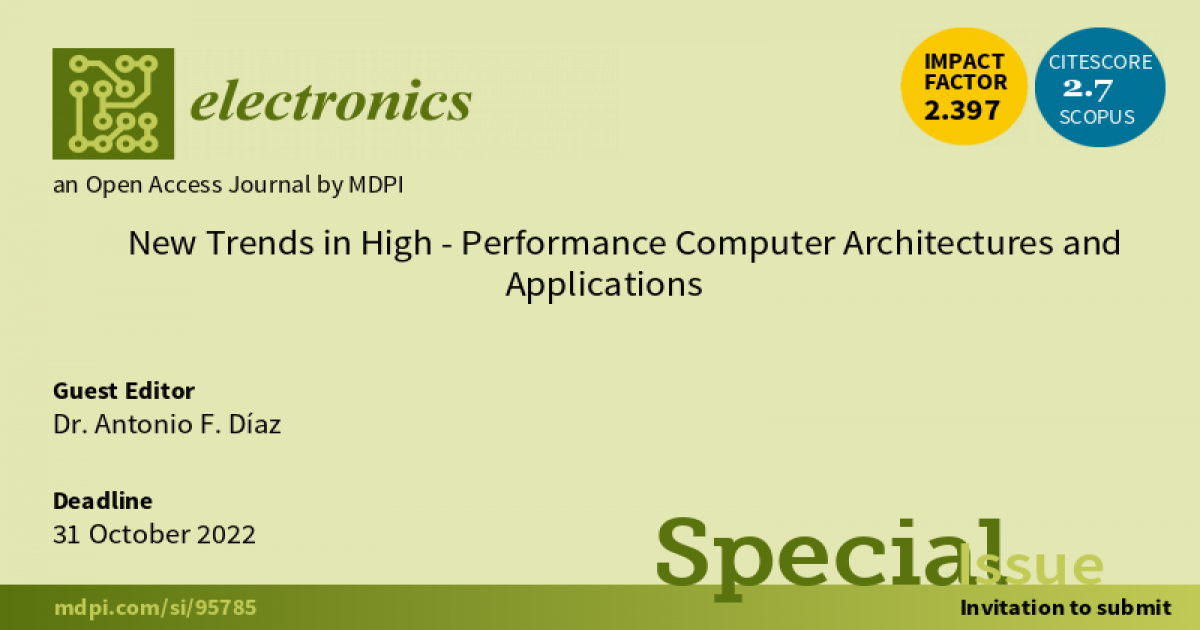New Trends in High-Performance Computer Architectures and Applications
A special issue of Electronics (ISSN 2079-9292). This special issue belongs to the section "Computer Science & Engineering".
Deadline for manuscript submissions: closed (31 October 2022) | Viewed by 10650

Special Issue Editor
Interests: computer architecture; communication networks; distributed systems; security; neutrino telescopes
Special Issues, Collections and Topics in MDPI journals
Special Issue Information
Dear Colleagues,
HPC is revolutionising our changing world and offers new resources to solve complex problems. This computational power rises steadily due to a continuous evolution of advanced hardware platforms, networks, parallelisation, distributed programming, and optimised algorithms. However, it is a great challenge to take advantage of this huge amount of resources.
In addition, cloud computing, intensive AI requirements, and new computational models have spurred advanced solutions based on accelerators and specialised designs. A combination of these technologies also requires elements that enrich the overall design to fulfil specific requirements such as reliability, fault tolerance, energy-efficient solutions, secure frameworks, scalability, load balancing, or monitoring.
Thanks to the creative vision of scientists and engineers that are one step ahead of the latest technologies, it is possible to find new solutions that improve the wellbeing of our society.
This Special Issue aims to gather innovative contributions with new approaches, proposals, techniques, and applications in this field. The topics of interest include but are not limited to:
- High-performance computer architecture
- High-performance computer system software
- Multi-core and multi-threaded architecture methods
- Applications related to high-performance computing
- Distributed systems
- Communication networks
- Network virtualisation
- High-performance computing in cloud platforms
- Data-intensive computing
- Optimal energy solutions
- Energy-aware scheduling
- Accelerators such as GPUs and TPUs
- I/O subsystems
- Hardware virtualisation and simulation
- Hardware security
Dr. Antonio F. Díaz
Guest Editor
Manuscript Submission Information
Manuscripts should be submitted online at www.mdpi.com by registering and logging in to this website. Once you are registered, click here to go to the submission form. Manuscripts can be submitted until the deadline. All submissions that pass pre-check are peer-reviewed. Accepted papers will be published continuously in the journal (as soon as accepted) and will be listed together on the special issue website. Research articles, review articles as well as short communications are invited. For planned papers, a title and short abstract (about 100 words) can be sent to the Editorial Office for announcement on this website.
Submitted manuscripts should not have been published previously, nor be under consideration for publication elsewhere (except conference proceedings papers). All manuscripts are thoroughly refereed through a single-blind peer-review process. A guide for authors and other relevant information for submission of manuscripts is available on the Instructions for Authors page. Electronics is an international peer-reviewed open access semimonthly journal published by MDPI.
Please visit the Instructions for Authors page before submitting a manuscript. The Article Processing Charge (APC) for publication in this open access journal is 2400 CHF (Swiss Francs). Submitted papers should be well formatted and use good English. Authors may use MDPI's English editing service prior to publication or during author revisions.
Keywords
- high-performance computing
- cluster computing
- simulation tools
- distributed computing
- parallelisation techniques
- computer architecture
- computer networks
- GPU
- energy-aware scheduling
- HPC-I/O systems
- SDN
- IaaS
- security





